The Critical Role of Self-Evaluation in an ISI Inspection
- A good SEF is the best evidence document we can give the Lead Inspector. It proves that we have met all the Independent School Regulations and Standards.
- This document is not just a formality; it’s a powerful tool for reflection, improvement, and showing our strengths.
Why Self-Evaluation Matters:
- Reflective Practice is a process that allows us to examine our practices critically. It helps us identify areas where we are doing well and areas where we need improvement.
- Evidence of Commitment: Thorough and accurate self-evaluation demonstrates our commitment to excellence in education. It shows that we are not just following standards but are actively engaged in enhancing our educational offerings.
- Preparation and Anticipation: We can anticipate potential focus areas during inspections by critically assessing our operations. This allows us to prepare more effectively, ensuring we can confidently present evidence and rationale for our methodologies.
- Empowerment: Engaging in the self-evaluation process empowers us by valuing our insights and experiences. It’s a collective effort that acknowledges the contributions of every staff member towards achieving our educational goals.
- Promotes Success: This document highlights our innovative practices and successes. It celebrates our accomplishments and shares what sets us apart as a leading educational institution.
Staff Role in the Process:
Staff insights, experiences, and reflections are invaluable to creating a comprehensive and authentic self-evaluation document.
Must Watch Videos on the SEF Process
Before looking at the ISI’s SEF Guidance, it is well worth watching the five videos below. The senior management team can either adopt the ISI format wholesale or tweak it to suit them. The videos below will definitely help the team define the best format that suits them.
ISI SEF Guidance
Purpose of self-evaluation
- Inspection forms a part of the wider assurance framework and should not be seen as the only form of quality assurance for schools. Internal school-based quality assurance, captured in a dynamic self-evaluation and review format as part of the school’s ongoing review process, supports schools over time in their pursuit of excellence and assures governors and relevant external agencies. We have received requests from schools and their associations to produce a template self-evaluation form aligned with the Framework to support schools with this process. We are pleased to provide schools with this self-evaluation format designed to help leaders at all levels articulate the impact of their leadership.
- We welcome engagement with schools and their associations in developing effective internal quality assurance practices. It is beneficial when rigorous internal and external assurance systems speak to each other. This, in turn, supports robust and independent external assurance through inspection, which reports to the Department for Education.
- The primary purpose of self-evaluation is for leaders and governors to evaluate the totality of provision at a school, provide assurance, and inform priorities for school improvement. This process can be a rich source of discussion and development within the school and should not require external facilitation or consultancy.
- While this self-evaluation guidance is available to all schools inspected by ISI, inspection inspectors will discuss self-evaluation in any form the school undertakes for their quality assurance processes. Whatever the method of self-evaluation, the proprietor(s)/governors and leaders must be familiar with the Standards requirements and undertake regular and robust internal assurance. This document is intended to support that process.
- Self-evaluation should be seen as a manageable, ongoing and embedded part of the school’s internal assurance process so that proprietor(s)/governors and leaders can meet their responsibilities under paragraph 34 of the Standards. Effective self-evaluation enables leaders at all levels to own and confidently articulate the impact of their decision-making.
- Similarly, inspection inspectors will want to understand leaders’ decision-making process to determine the appropriateness of leaders’ knowledge and skills and how effectively leaders fulfil their responsibilities to ensure that the Standards are met consistently. To support this, the proposed methodology in Part 2 of this guidance enables leaders to capture their ongoing decision-making processes in areas relevant to the Standards, thereby articulating the impact of their leadership at any point in time, including during inspection.
- Therefore, the summary prompt table in Part 2 prompts leaders to capture their decision-making’s current and planned impact. It allows leaders to capture milestones in reaching the intended outcome and record evidence of impact. Leaders may use this approach to inform their discussions with inspectors before inspectors evaluate inspection evidence. Leaders should not expect inspectors to take the self-evaluation away and read it in isolation. Self-evaluation is not evidence in itself that Standards are met.
- We understand that this presents a different and more dynamic approach to self-evaluation from our previous Framework and emphasise that this self-evaluation format is optional. We are offering ongoing support via webinars, conference attendances and responding to FAQs to support schools at the start of and during the Framework cycle.
- The Framework already provides leaders with a clear structure to demonstrate and articulate how leaders fulfil their responsibility to ensure that the Standards are met. This self-evaluation guidance follows the same structure.
- Leaders are drawn to the advice regarding signposting significant strengths on inspection in the Framework. School leaders are reminded that significant strengths should be apparent to the inspection team in their ongoing inspection activity without signposting from school leaders.
- Schools will only be expected or encouraged to upload their self-evaluation on the ISI portal after or during the inspection.
Terminology
14. For this document, ‘leaders’ refers to all those with leadership and management responsibility at a school. ‘Proprietor(s)/governors’ refers to the person or persons who has/have responsibility under paragraph 34 of the Independent School Standards to ensure that those with leadership and management responsibility:
- (a) demonstrate good skills and knowledge appropriate to their role so that the independent school standards are met consistently;
- (b) fulfil their responsibilities effectively so that the independent school standards are met consistently and
- (c) actively promote the wellbeing of pupils.
15. The Independent School Standards and other applicable standards and regulations are collectively called ‘the Standards’ throughout this document.
How to use this guidance
17. This guidance has three parts:
Part 1: Regulatory audit
This part enables schools to keep and update records of training, health and safety checks, and provision of information that inspectors will request at the start of an inspection.
Part 2: Decision-making and impact evaluation
This part forms the main section of the self-evaluation process. It provides proprietor(s)/governors and leaders with a structured approach to prompt questions and focus areas for self-evaluation. This approach informs ongoing evaluation by school leaders and governors of the effective implementation of decision-making at the school, as required by relevant standards and regulations.
Part 3: Frequently Asked Questions
This part with have a link to the FAQ page on the ISI website and will contain self-evaluation-specific questions and answers. It will be updated regularly.
18. Parts 1 and 2 are the main focus on the self-evaluation process, with the self-evaluation methodology outlined in Part 2 demonstrating the core principles of our approach to inspection, which are contained in the Framework:
- Manageability: ISI understands that inspection is a significant event for a school and will promote practices on inspection that, as far as possible, align with the day-to-day life of the school and do not cause unnecessary workload for the school or the inspection team. This is why we are promoting an ongoing and reflective approach to self-evaluation. Self-evaluation should not be an exercise that is only undertaken to prepare for inspection.
- Collaboration: Inspectors will seek to work alongside school leaders and staff where appropriate, sharing emerging findings.
- Triangulation and typicality: Inspectors will consider a range of evidence when forming evaluations on inspection. Inspectors will look for evidence of what would be typical provision for pupils at the school over time. Inspectors will consider a range of connected evidence, including school records and confirm the context of what inspectors are seeing, hearing and reading on inspection.
- Proportionality: Inspectors will exercise professional judgment when judging how much a school meets the Standards. Inspectors will take a proportionate approach when there are some relative weaknesses or minor errors that can be easily rectified. Inspectors will consider if those weaknesses amount to a failure to meet one or more of the Standards. Weaknesses or errors indicative of systemic failings in the school’s processes and provision will lead to a judgement that the relevant Standards are unmet.
Part 1: Regulatory audit
Records of training, health and safety checks, provision of information
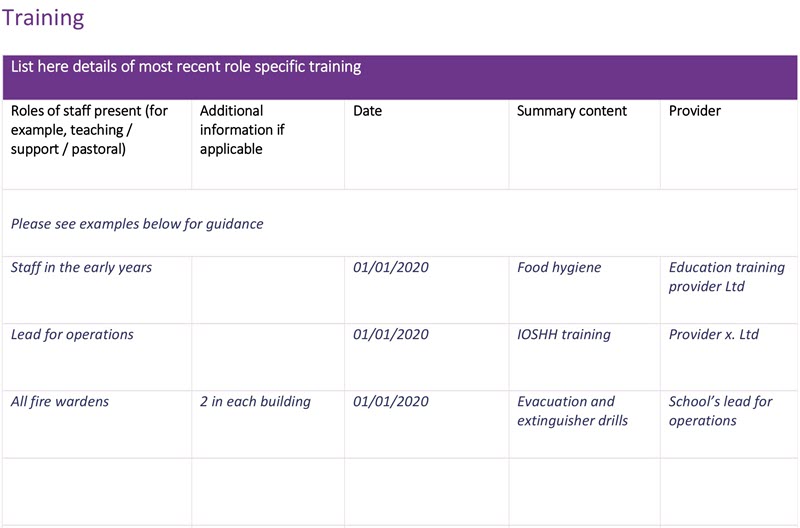
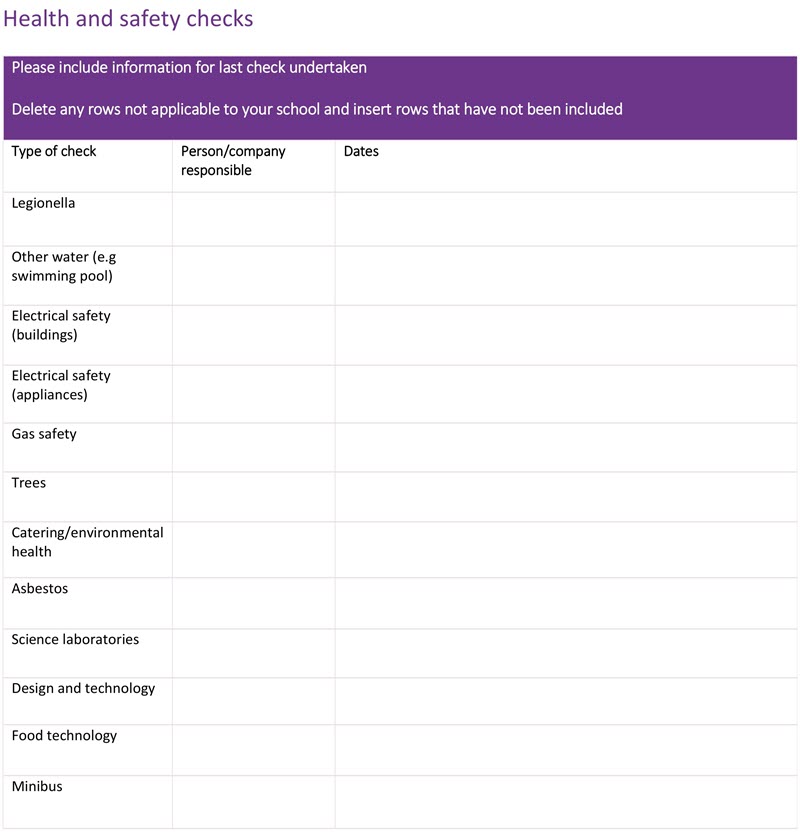
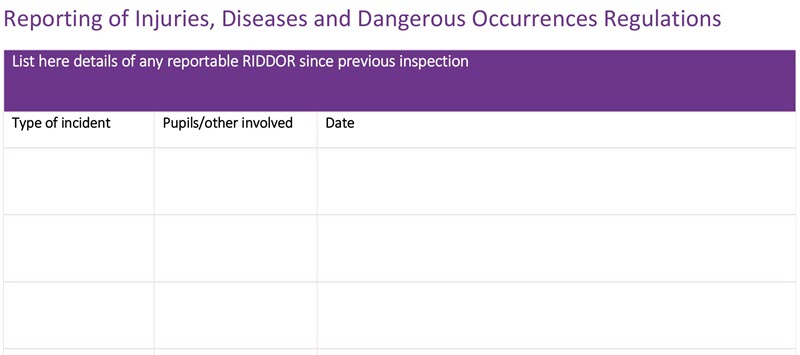
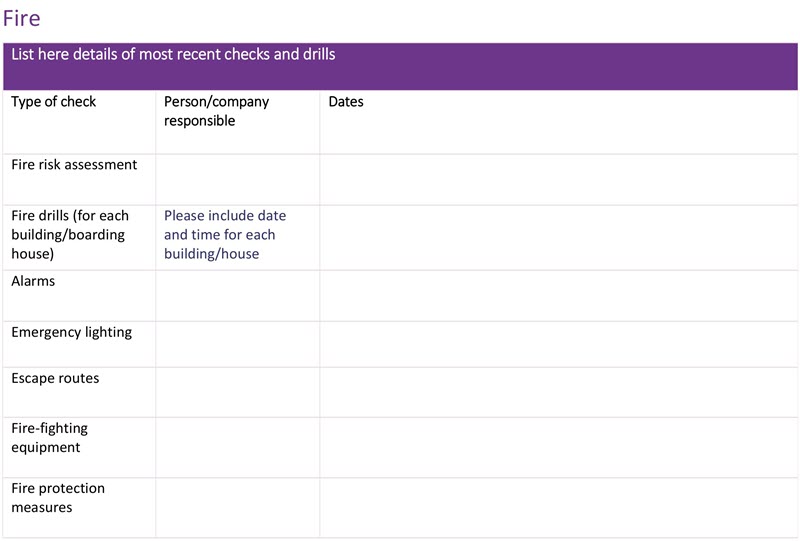
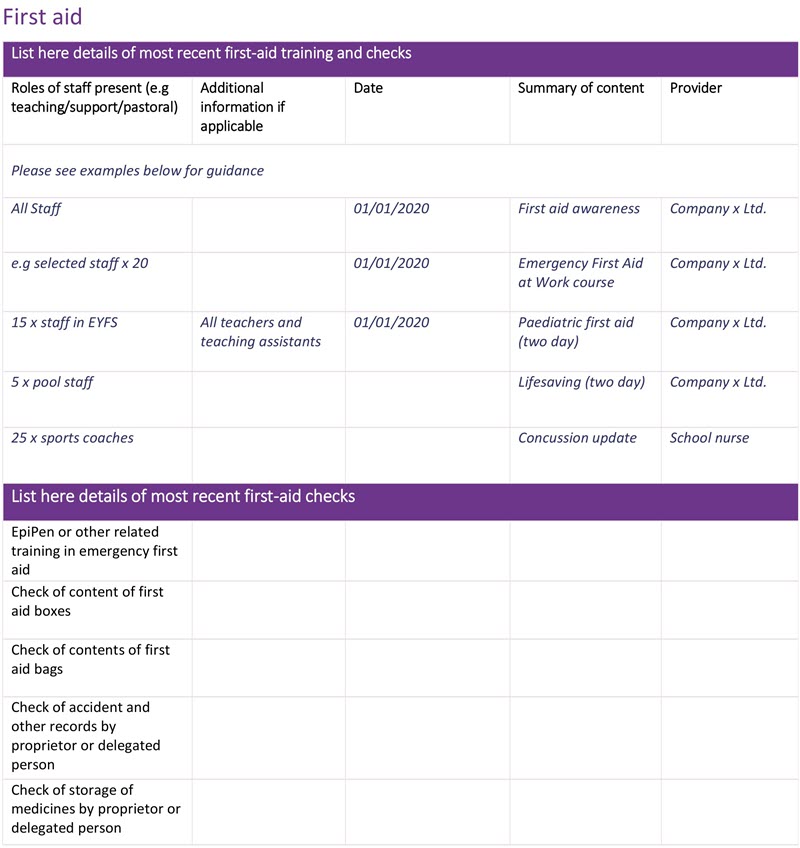

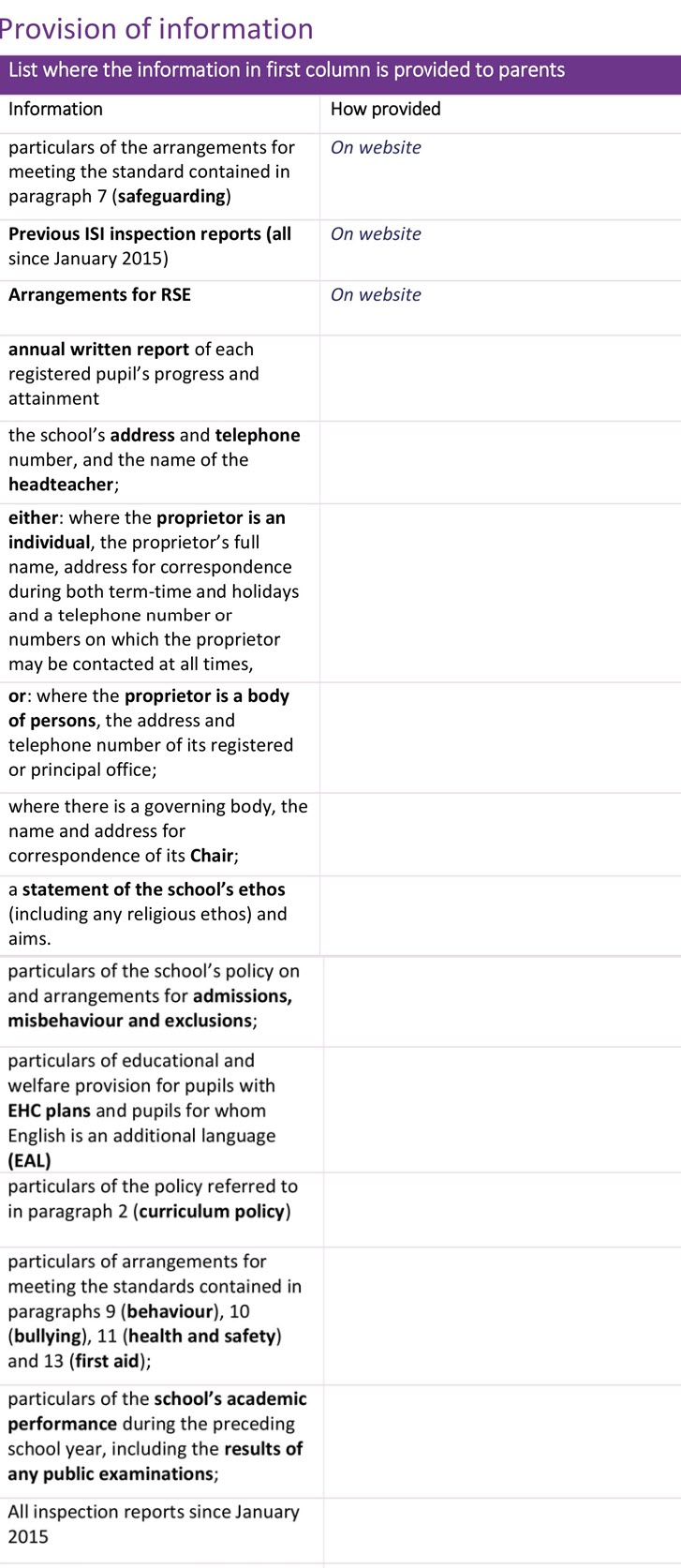
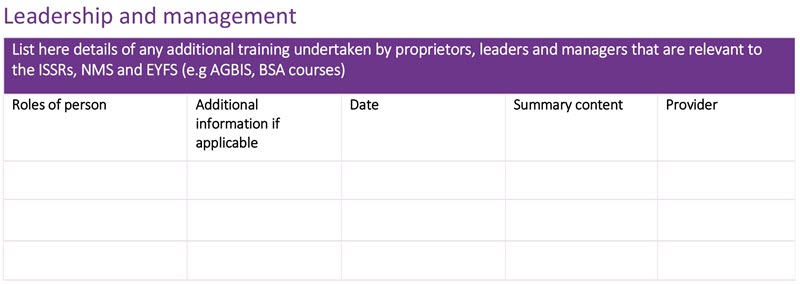
Part 2: Self-evaluation guidance:
Decision-making and impact evaluation
20. This is for reference only. The ISI Framework must be referred to in total throughout the inspection process:
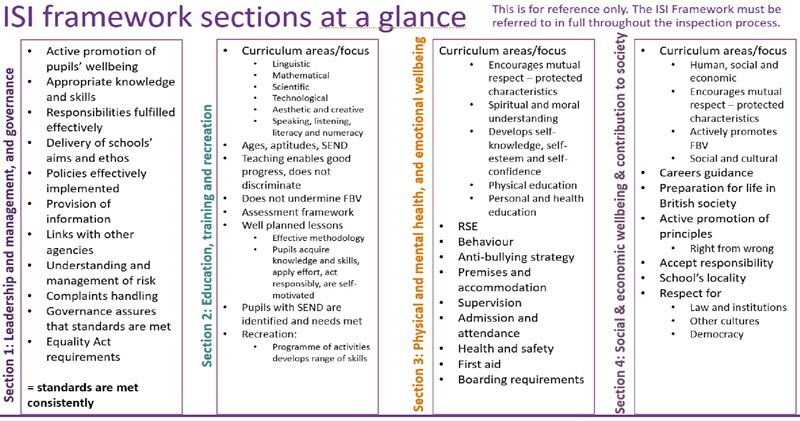
21. The table above overviews Sections 1 – 4 of the ISI framework and focus areas. The inspection of safeguarding follows the requirements of the most recent statutory guidance.
22. Prompt questions which the school leaders and governors may find helpful are indicated with a yellow highlighter and summarised in a summary prompt table, which can be used to capture self-evaluations at all levels of leadership in the school.23. Focus areas related to sections of the Framework and associated Standards are indicated in green highlighter. School leaders and governors could apply the prompt questions to focus areas and capture the answers succinctly in the relevant section. Focus areas in this document are headings only and do not reference the detailed requirements of the Standards, which can be found in the Framework document.
24. Leaders must be familiar with the Standards requirements and apply this knowledge to inform their evaluation process.
Use of self-evaluation on inspection
25. This self-evaluation is intended to inform ongoing evaluation by school leaders and governors of the effective implementation of decision-making at the school, as required by relevant standards and regulations. For example, it may be used to aid school leaders’ and governors’ articulation of the impact of their leadership in meetings and discussions. Inspectors will not expect to be given the school’s self-evaluation to read separately from its use as a reference point in meetings or discussions.
Prompt questions
26. The following suggested prompt questions may be used to map and evaluate the decision-making and impact relating to any area of provision referred to in the Framework. They can also be applied to specific Standards and other priorities that school leaders consider appropriate for close evaluation. The prompt questions are summarised as summary prompts in the right-hand column for ease of reference.
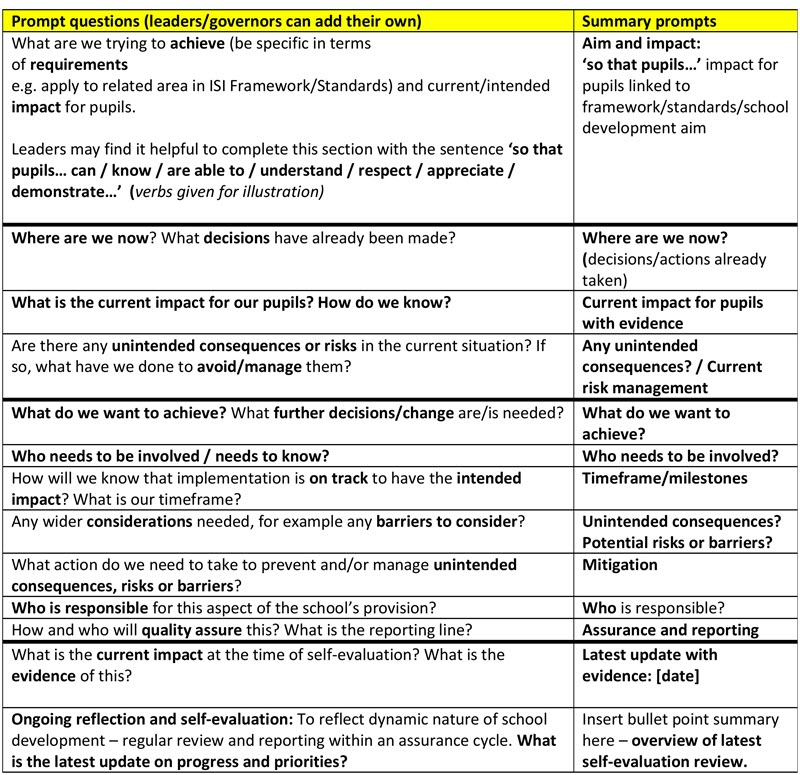
The summary prompt table: a suggested method for distributed self- evaluation
27. There is no preferred method for self-evaluation. Inspectors will be interested to see self-evaluation in whatever form the school chooses. The following summary prompt table is provided as a suggested method.
28. If leaders and governors choose to use the summary prompt table below, it can be used for each area of focus. It can form the basis for self-evaluation of a focus area and contribute to the whole school self-evaluation process.
29. Individual summary prompt tables may be combined into a whole-school self-evaluation document where any/all areas of focus are being evaluated by school leaders and assured by governors (see final row).
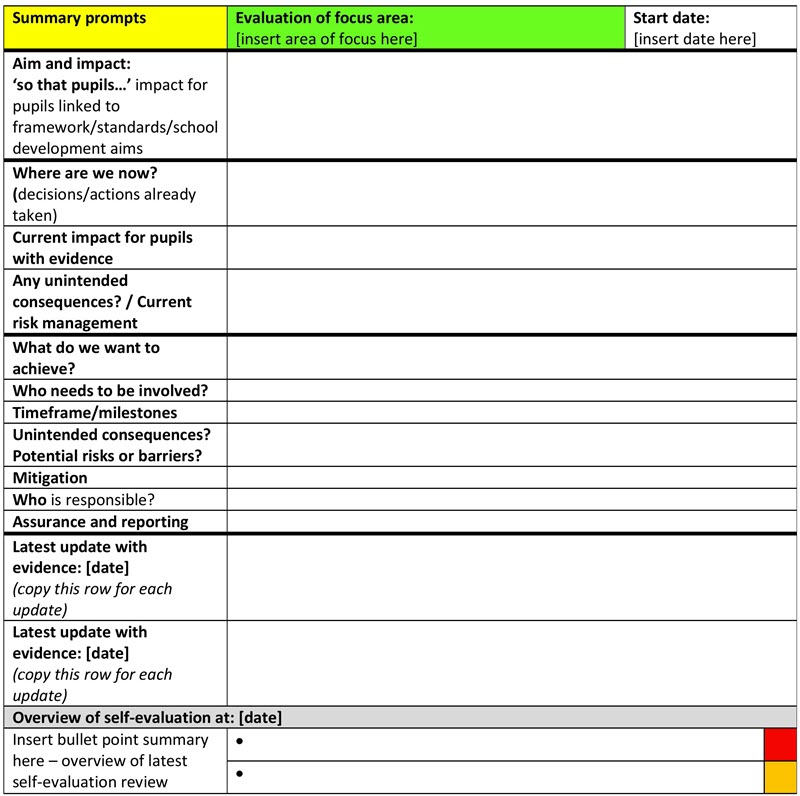
Section 1: Leadership and management, and governance
30. Read Section 1 of the Framework (pages 10 and 11) and identify focus areas for evaluation. For example, but not limited to:

31. Copy and complete summary prompt tables to evaluate the above focus areas. These tables can be distributed to leaders responsible for focus areas and form the basis for reflection and contribution to the whole school self-evaluation process.
Section 2: Pupils’ education, training and recreation
32. Read Section 2 of the Framework (pages 11 to 14) and identify focus areas for evaluation. For example, but not limited to:

33. Copy and complete summary prompt tables to evaluate the above focus areas. These tables can be distributed to leaders responsible for focus areas and form the basis for reflection and contribution to the whole school self-evaluation process.
Section 3: Pupils’ physical and mental health and emotional wellbeing
34. Read Section 3 of the Framework (pages 14 and 15) and identify focus areas for evaluation. For example, but not limited to:

* For self-evaluation, leaders may choose to focus on these areas within the school context and setting under Section 3.
35. Copy and complete summary prompt tables from above as required to evaluate the above focus areas. These tables can be distributed to leaders responsible for focus areas and form the basis for reflection and contribution to the whole school self-evaluation process.
Section 4: Pupils’ social and economic wellbeing and contribution to society
36. Read Section 4 of the Framework (pages 16 and 17) and identify focus areas for evaluation. For example, but not limited to:
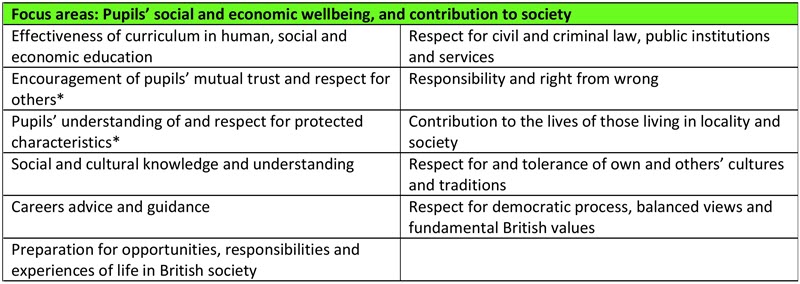
* For self-evaluation, leaders may choose to focus on these areas within the school context and setting under Section 4.
37. Copy and complete summary prompt tables from above as required to evaluate the above focus areas. These tables can be distributed to leaders responsible for focus areas and form the basis for reflection and contribution to the whole school self-evaluation process.
Safeguarding
38. Read the latest statutory guidance in Keeping Children Safe in Education and Working Together to Safeguard Children, which applies to the proprietors of independent schools, amongst others. Therefore, all areas of statutory guidance are focus areas for the self-evaluation of safeguarding. Therefore, reading and understanding the latest statutory guidance is essential to the role of proprietors/governing bodies and everyone who works with children at the school.
39. The purpose of self-evaluation of safeguarding is to ascertain whether safeguarding practice and culture at the school is effective in meeting the requirements of the latest statutory guidance and other applicable regulations.
40. The latest statutory guidance contained in Keeping Children Safe in Education and Working Together to Safeguard Children and other safeguarding regulations emphasises that safeguarding and promoting the welfare of children is everyone’s responsibility and that everyone who comes into contact with children and families has a role to play.
41. Proprietors’/governors’ resulting knowledge and understanding should inform the self-evaluation of safeguarding at the school.

42. Copy and complete summary prompt tables from above as required to evaluate the culture and practice of safeguarding.
Early Years
43. Read the section of the Framework (pages 17 and 18) on early years and identify focus areas for evaluation. For example, but not limited to:

44. Copy and complete summary prompt tables from above as required to evaluate the above focus areas. These tables can be distributed to leaders responsible for focus areas and form the basis for reflection and contribution to the whole school self-evaluation process.
Part 3: Frequently asked questions on self-evaluation
47. What is the relationship between the school’s development plan and this self-evaluation format? There could be duplication.
Answer: Schools may adapt this approach to fit in with their existing development planning cycle, which will include some element of self-review to identify priorities. Development planning is, by nature, future-orientated, and the self-evaluation process reflects the previous and current situation. This process is captured in the structure of the summary prompt table included in this guidance. In using this approach with focus areas aligned to the Standards, proprietors and leaders will be supported to review the extent to which they meet their responsibilities to the regulator. This approach allows other priorities for the school to be included in development planning.
48. Can we upload it to the ISI portal before the inspection so the inspectors can read it before we meet?
Answer: No. The only part that can be uploaded at the start of an inspection (and is available separately) is the regulatory audit (Part 1). Inspectors will not take the school’s self-evaluation away and read it in isolation on inspection. As part of the principle of collaboration, if available, it will form the basis for consideration of evidence on inspection. It will not be taken as evidence in its own right that Standards are met. It may be helpful for leaders to signpost to inspectors where the evidence is so it can be considered first-hand by inspectors on inspection.